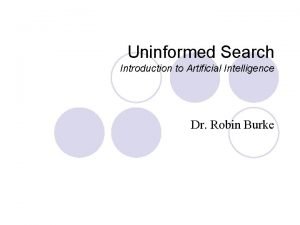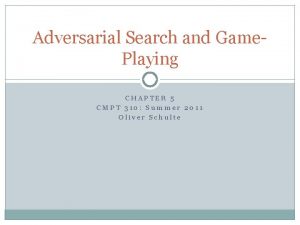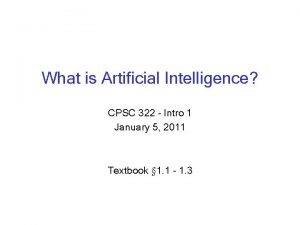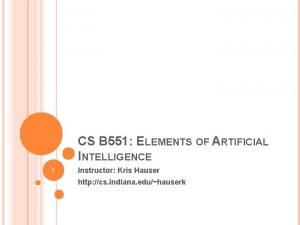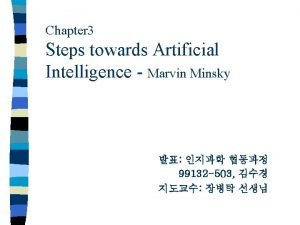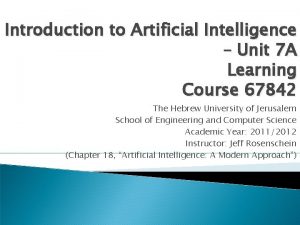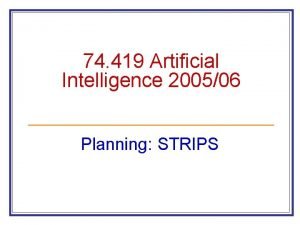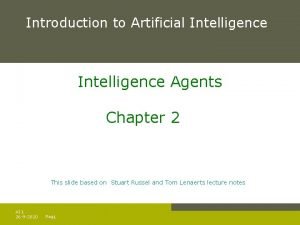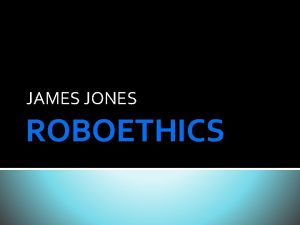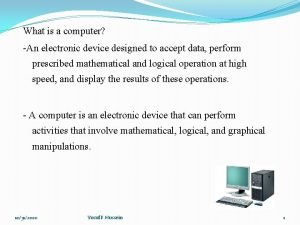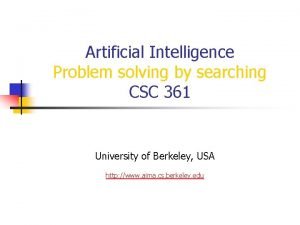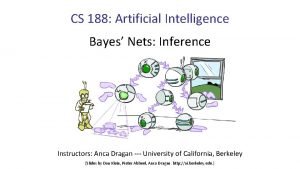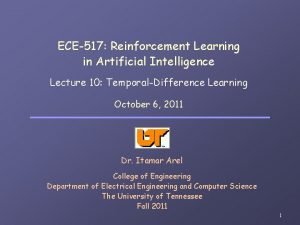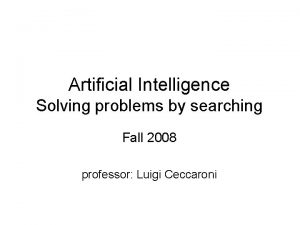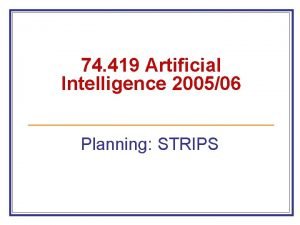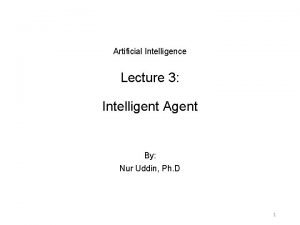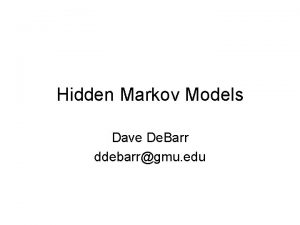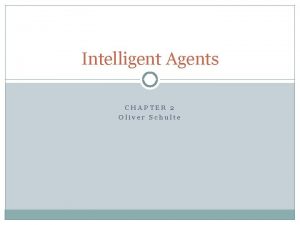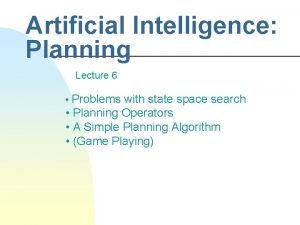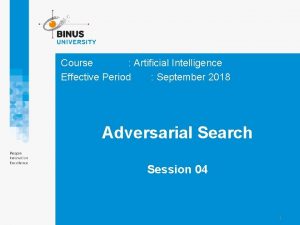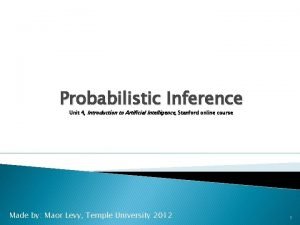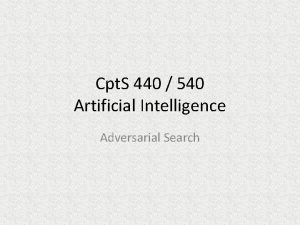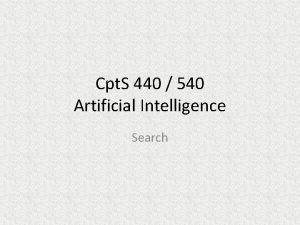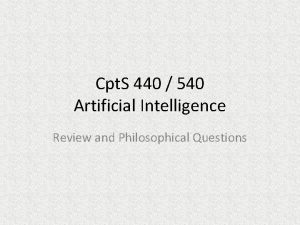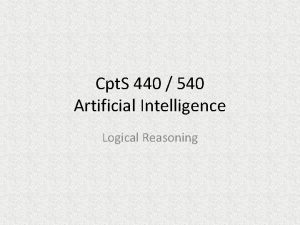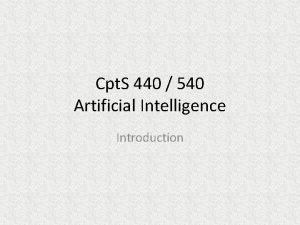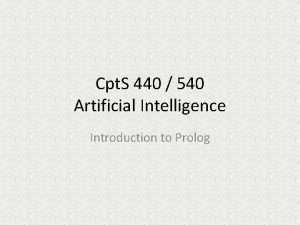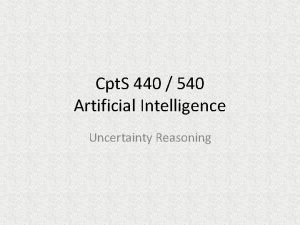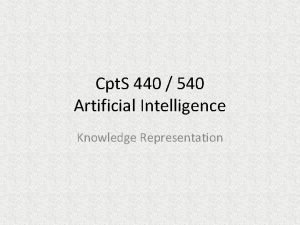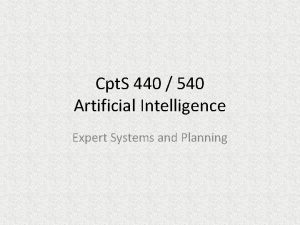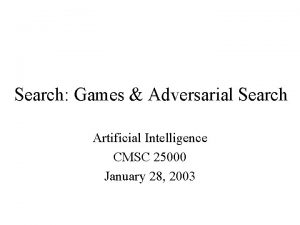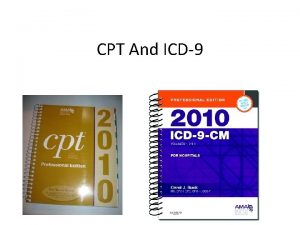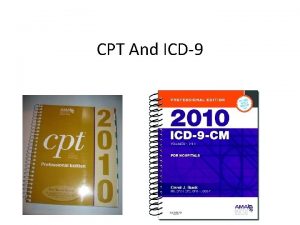Cpt S 440 540 Artificial Intelligence Adversarial Search































































- Slides: 63

Cpt. S 440 / 540 Artificial Intelligence Adversarial Search

Game Playing

Why Study Game Playing? • • Games allow us to experiment with easier versions of real-world situations Hostile agents act against our goals Games have a finite set of moves Games are fairly easy to represent Good idea to decide about what to think Perfection is unrealistic, must settle for good One of the earliest areas of AI – Claude Shannon and Alan Turing wrote chess programs in 1950 s • The opponent introduces uncertainty • The environment may contain uncertainty (backgammon) • Search space too hard to consider exhaustively – Chess has about 1040 legal positions – Efficient and effective search strategies even more critical • Games are fun to target!

Assumptions • • • Static or dynamic? Fully or partially observable? Discrete or continuous? Deterministic or stochastic? Episodic or sequential? Single agent or multiple agent?

Zero-Sum Games • Focus primarily on “adversarial games” • Two-player, zero-sum games As Player 1 gains strength Player 2 loses strength and vice versa The sum of the two strengths is always 0.

Search Applied to Adversarial Games • Initial state – Current board position (description of current game state) • Operators – Legal moves a player can make • Terminal nodes – Leaf nodes in the tree – Indicate the game is over • Utility function – Payoff function – Value of the outcome of a game – Example: tic tac toe, utility is -1, 0, or 1

Using Search • Search could be used to find a perfect sequence of moves except the following problems arise: – There exists an adversary who is trying to minimize your chance of winning every other move • You cannot control his/her move – Search trees can be very large, but you have finite time to move • • Chess has 1040 nodes in search space With single-agent search, can afford to wait Some two-player games have time limits Solution? – Search to n levels in the tree (n ply) – Evaluate the nodes at the nth level – Head for the best looking node

Game Trees • Tic tac toe • Two players, MAX and MIN • Moves (and levels) alternate between two players

Minimax Algorithm • Search the tree to the end • Assign utility values to terminal nodes • Find the best move for MAX (on MAX’s turn), assuming: – MAX will make the move that maximizes MAX’s utility – MIN will make the move that minimizes MAX’s utility • Here, MAX should make the leftmost move • Minimax applet

Minimax Properties • Complete if tree is finite • Optimal if play against opponent with same strategy (utility function) • Time complexity is O(bm) • Space complexity is O(bm) (depth-first exploration) • If we have 100 seconds to make a move – Can explore 104 nodes/second – Can consider 106 nodes / move • Standard approach is – Apply a cutoff test (depth limit, quiescence) – Evaluate nodes at cutoff (evaluation function estimates desirability of position)

Static Board Evaluator • We cannot look all the way to the end of the game – Look ahead ply moves – Evaluate nodes there using SBE • Tic Tac Toe example – #unblocked lines with Xs - #unblocked lines with Os • Tradeoff – Stupid, fast SBE: Massive search • These are “Type A” systems – Smart, slow SBE: Very little search • These are “Type B” systems – Humans are Type B systems – Computer chess systems have been more successful using Type A – They get better by searching more ply

Comparison 20 40 Deep Blue … 18 16 14 ply 12 10 8 Belle 6 Belle Deep Hitech Thought Gary Belle Kasparov Belle Anatoly Karpov Bobby Fischer 4 2 0 1. 4 1. 6 1. 8 2 2. 4 U. S. Chess Federation Rating x 103 2. 6 2. 8

Example • Chess, SBE is typically linear weighted sum of features – SBE(s) = w 1 f 1(s) + w 2 f 2(s) + … + wnfn(s) – E. g. , w 1 = 9 • F 1(s) = #white queens - #black queens • For chess: – 4 ply is human novice – 8 ply is typical PC or human master – 12 ply is grand master

Example • Othello • SBE 1: #white pieces - #black pieces • SBE 2: weighted squares

Alpha-Beta Pruning • Typically can only look 3 -4 ply in allowable chess time • Alpha-beta pruning simplifies search space without eliminating optimality – – By applying common sense If one route allows queen to be captured and a better move is available Then don’t search further down bad path If one route would be bad for opponent, ignore that route also Max 2 7 1 No need to look here! Maintain [alpha, beta] window at each node during depth-first search alpha = lower bound, change at max levels beta = upper bound, change at min levels

Example

Example

Example

Example

Example

Example

Example

Example

Example

Example

Example

Example

Example

Example

Example

Example

Example

Example

Example

Example

Example

Example

Example

Example

Example

Example

Example

Example

Example

Example

Example

Example

Example

Example

Example

Example

Example

Example

Example

Bad and Good Cases for Alpha-Beta Pruning • Bad: Worst moves encountered first 4 MAX +----------------+ 2 3 4 MIN +----+----+ 6 4 2 7 5 3 8 6 4 MAX +--+ +-+-+ +--+ +--+--+ 6 5 4 3 2 1137 4 5 2 3 8 2 1 61 2 4 • Good: Good moves ordered first 4 MAX +----------------+ 4 3 2 MIN +----+----+ 4 6 8 3 x x 2 x x MAX +--+ +-+-+ 4 2 6 x 8 x 3 2 1 21 • If we can order moves, we can get more benefit from alpha-beta

Alpha Beta Properties • Pruning does not affect final result • Good move ordering improves effectiveness of pruning • With perfect ordering, time complexity is O(bm/2)

Problems with a fixed ply: The Horizon Effect Lose queen Lose pawn The “look ahead horizon” Lose queen!!! • Inevitable losses are postponed • Unachievable goals appear achievable • Short-term gains mask unavoidable consequences (traps)

Solutions • How to counter the horizon effect – Feedover • Do not cut off search at non-quiescent board positions (dynamic positions) • Example, king in danger • Keep searching down that path until reach quiescent (stable) nodes – Secondary Search • Search further down selected path to ensure this is the best move – Progressive Deepening • Search one ply, then two ply, etc. , until run out of time • Similar to IDS

Variations on 2 -Player Games Multiplayer Games to move 1 (1 2 3) +---------+ +-----------+ 2 (1 2 3) (-1 5 2) +----+ +--------+ +-------+ 3 (1 2 3) (6 1 2) (-1 5 2) (5 4 5) / / / / 1 (1 2 3) (4 2 1) (6 1 2) (7 4 -1) (5 -1 -1) (-1 5 2) (7 7 -1) (5 4 5) Each player maximizes utility Each node stores a vector of utilities Entire vector is backed up the tree 3 -player example: If in leftmost state, should player 3 choose first move because higher utility values? • Result will be terminal state with utility values (v 1=1, v 2=2, v 3=3) • This vector is backed up to the parent node • Need to consider cooperation among players • •

Nondeterministic Games • In backgammon, the dice rolls determine legal moves

Nondeterministic Games

Nondeterministic Game Algorithm • Just like Minimax except also handle chance nodes • Compute Expect. Minimax. Value of successors – If n is terminal node, then Expect. Minimax. Value(n) = Utility(n) – If n is a Max node, then Expect. Minimax. Value(n) = maxs Successors(n) Expect. Minimax. Value(s) – If n is a Min node, then Expect. Minimax. Value(n) = mins Successors(n) Expect. Minimax. Value(s) – If n is a chance node, then Expect. Minimax. Value(n) = s Successors(n) P(s) * Expect. Minimax. Value(s)

Status of AI Game Players • Tic Tac Toe • Poker • Othello • Checkers – Tied for best player in world – Computer better than any human – Human champions now refuse to play computer • Scrabble – Maven beat world champions Joel Sherman and Matt Graham • Backgammon – 1992, Tesauro combines 3 -ply search & neural networks (with 160 hidden units) yielding top-3 player • Bridge – Gib ranked among top players in the world – Pokie plays at strong intermediate level – 1994, Chinook ended 40 -year reign of human champion Marion Tinsley • Chess – 1997, Deep Blue beat human champion Gary Kasparov in six-game match – Deep Blue searches 200 M positions/second, up to 40 ply – Now looking at other applications (molecular dynamics, drug synthesis) • Go – 2008, Mo. Go running on 25 nodes (800 cores) beat Myungwan Kim – $2 M prize available for first computer program to defeat a top player
 Uninformed search in artificial intelligence
Uninformed search in artificial intelligence State space representation in ai
State space representation in ai Informed search and uninformed search in ai
Informed search and uninformed search in ai Uninformed search is also called as
Uninformed search is also called as Cpt = cpt + 1
Cpt = cpt + 1 Adversarial search problems uses
Adversarial search problems uses Artificial intelligence applications institute
Artificial intelligence applications institute 15-780 graduate artificial intelligence
15-780 graduate artificial intelligence References for artificial intelligence
References for artificial intelligence Artificial intelligence assessment
Artificial intelligence assessment Hbr ai and machine learning
Hbr ai and machine learning Artificial intelligence devices
Artificial intelligence devices Artificial intelligence devices
Artificial intelligence devices Advantages of mycin expert system
Advantages of mycin expert system Cpsc 322: introduction to artificial intelligence
Cpsc 322: introduction to artificial intelligence Searching for solutions in artificial intelligence
Searching for solutions in artificial intelligence Artificial intelligence the next digital frontier?
Artificial intelligence the next digital frontier? The number of fuzzy propositions
The number of fuzzy propositions Csci-b 551 elements of artificial intelligence
Csci-b 551 elements of artificial intelligence Bin zaid face
Bin zaid face Steps toward artificial intelligence
Steps toward artificial intelligence Artificial intelligence devices
Artificial intelligence devices Types of artificial intelligencel
Types of artificial intelligencel Unit 7 artificial intelligence
Unit 7 artificial intelligence Rule based deduction system
Rule based deduction system Procedural knowledge in ai
Procedural knowledge in ai Water jug problem using dfs
Water jug problem using dfs Strips planning example
Strips planning example Levels of language analysis
Levels of language analysis Peas in ai examples
Peas in ai examples Conceptual graph in artificial intelligence tutorial
Conceptual graph in artificial intelligence tutorial Types of agents in artificial intelligence
Types of agents in artificial intelligence Conclusion of artificial intelligence
Conclusion of artificial intelligence Ethics of artificial intelligence
Ethics of artificial intelligence Computational intelligence ppt
Computational intelligence ppt What math is used in artificial intelligence
What math is used in artificial intelligence Cs188 artificial intelligence
Cs188 artificial intelligence Csc 450
Csc 450 Searching for solutions in artificial intelligence
Searching for solutions in artificial intelligence Electronic device designed to accept data
Electronic device designed to accept data Semantic network in ai
Semantic network in ai Cse 471 asu
Cse 471 asu Problem solving by searching in artificial intelligence
Problem solving by searching in artificial intelligence Artificial intelligence applications institute
Artificial intelligence applications institute Inference by enumeration in artificial intelligence
Inference by enumeration in artificial intelligence Passive reinforcement learning in artificial intelligence
Passive reinforcement learning in artificial intelligence Solving problems by searching artificial intelligence
Solving problems by searching artificial intelligence Artificial intelligence devices
Artificial intelligence devices Inference in first-order logic
Inference in first-order logic Cpsc 322 ubc
Cpsc 322 ubc Colbert, stephen. home page. 1 nov. 2006.
Colbert, stephen. home page. 1 nov. 2006. Introduction to artificial intelligence and expert systems
Introduction to artificial intelligence and expert systems Strips planning
Strips planning Omniscience in artificial intelligence
Omniscience in artificial intelligence 15-780 graduate artificial intelligence
15-780 graduate artificial intelligence Artificial intelligence chapter 1
Artificial intelligence chapter 1 Artificial intelligence: a modern approach
Artificial intelligence: a modern approach Artificial intelligence applications institute
Artificial intelligence applications institute Part picking robot peas
Part picking robot peas Planning in artificial intelligence
Planning in artificial intelligence Optimal decisions in games in artificial intelligence
Optimal decisions in games in artificial intelligence Difference between a star and ao star
Difference between a star and ao star 15-780 graduate artificial intelligence
15-780 graduate artificial intelligence Inference by enumeration in artificial intelligence
Inference by enumeration in artificial intelligence
